Project Runway
A recent landscape design competition sought to rethink the Vatnsmýri airport grounds in Reykjavík, Iceland, putting those old runways to use, for instance, as new urban park space. The entries to the competition are quite interesting, in fact, so I've posted some of them, below, focusing on one particular project at the end of this post (so please scroll down if you've already read about this competition).
First, then, here's the old Vatnsmýri airport and its earthen geometry of intersecting runways. This is the site – star-like and stretching out to its surrounding landscapes – within which the designers had to work.
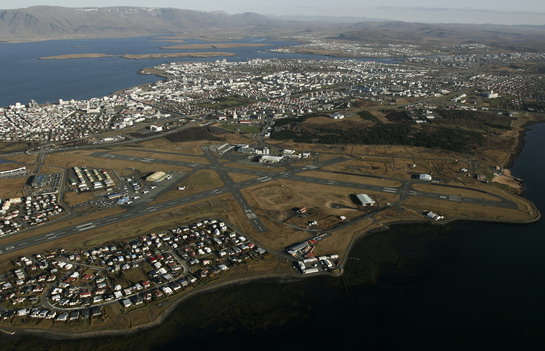
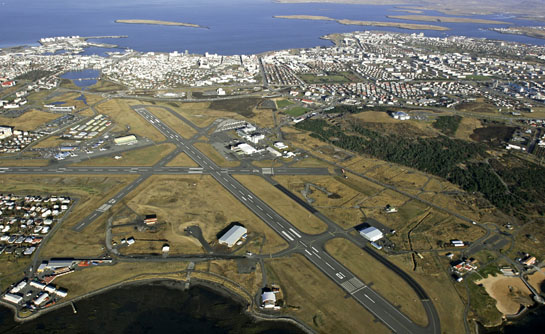 [Images: The Vatnsmýri airport grounds, Reykjavík, Iceland. Photos courtesy of the Reykjavík City Planning Committee].
[Images: The Vatnsmýri airport grounds, Reykjavík, Iceland. Photos courtesy of the Reykjavík City Planning Committee].
And here are some of the project entries, which I have posted in order, from shortlisted entries through to the big prize winners – but I have selected them on the purely superficial criterion of my own visual interest. Some of these projects, including two grand prize winners, are, I'm sure, absolutely fascinating, but small JPGs of their proposals simply don't give you very much to work with.
So, with genuine apologies to those designers whose work does not appear here, take a look at some of the entries.
 [Image: By Alexander D'Hooghe, et al.].
[Image: By Alexander D'Hooghe, et al.].
 [Image: By Antonello Boatti, Birgir Breiðdal, and Nicola Ferrara].
[Image: By Antonello Boatti, Birgir Breiðdal, and Nicola Ferrara].
 [Image: By Lola E. Sheppard and Mason White].
[Image: By Lola E. Sheppard and Mason White].
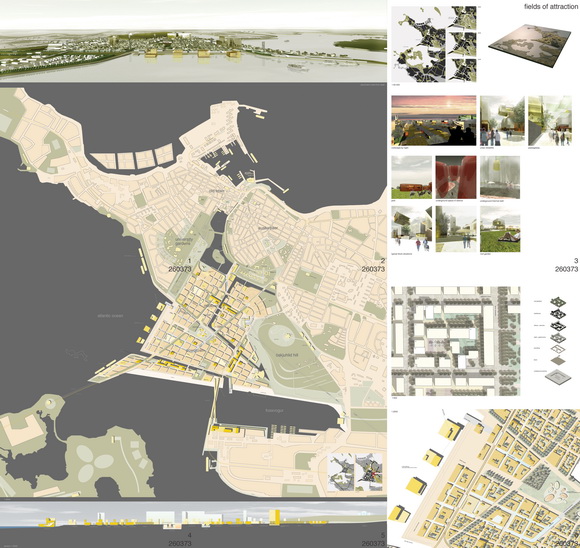 [Image: By Rolf J. Teloh, et al.].
[Image: By Rolf J. Teloh, et al.].
 [Image: By Thomas Forget and Jonathan F. Bell].
[Image: By Thomas Forget and Jonathan F. Bell].
 [Image: By Andrés Perea Ortega, et al.].
[Image: By Andrés Perea Ortega, et al.].
 [Image: By Beatriz Ramo, et al.].
[Image: By Beatriz Ramo, et al.].
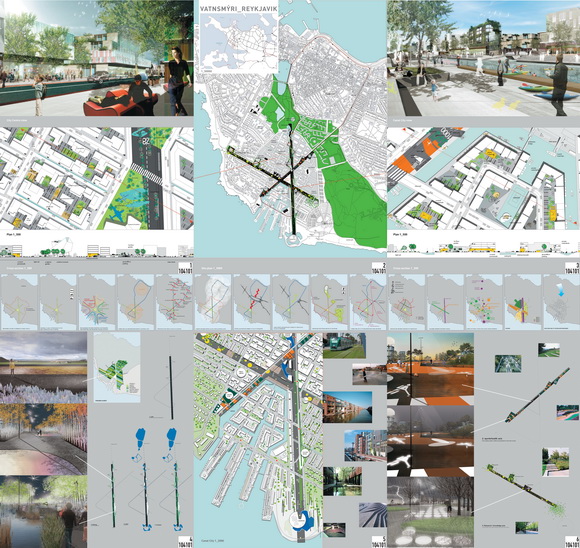 [Image: By Peer T. Jeppesen, et al.].
[Image: By Peer T. Jeppesen, et al.].
 [Image: By Belinda Kerry, Andrew Lee, Fiona Harrisson, and Blake F. Bowers].
[Image: By Belinda Kerry, Andrew Lee, Fiona Harrisson, and Blake F. Bowers].
 [Image: By Manuel Lodi, et al.].
[Image: By Manuel Lodi, et al.].
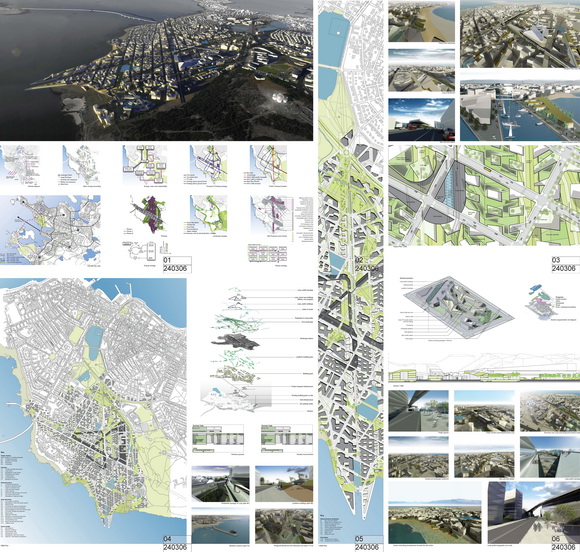 [Image: By Jeff Turko, Guðjón Þór Erlendsson, Dagmar Sirch, and Sibyl Trigg].
[Image: By Jeff Turko, Guðjón Þór Erlendsson, Dagmar Sirch, and Sibyl Trigg].
 [Image: By Graeme Massie, Stuart Dickson, Alan Keane, and Tim Ingleby].
[Image: By Graeme Massie, Stuart Dickson, Alan Keane, and Tim Ingleby].
And now I want to zero-in on one of the projects.
Here, then, is a quick exploration of a shortlisted entry by Lola E. Sheppard and Mason White of the Toronto-based firm Lateral Architecture.
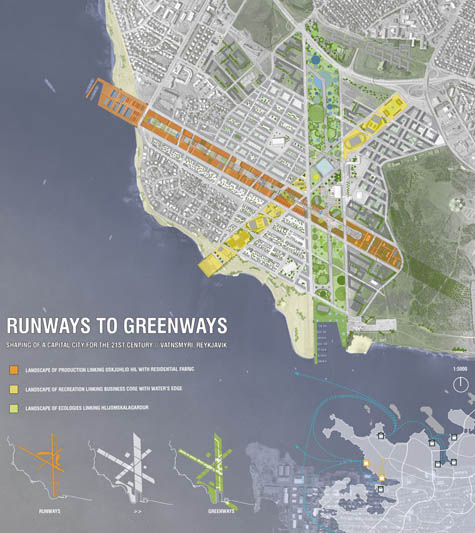 [Image: By Lola E. Sheppard and Mason White].
[Image: By Lola E. Sheppard and Mason White].
Their project begins, we read, "by establishing 'no-build' zones or public landscapes. The figure of the runway is used to identify three primary axes. Each former runway is converted into a 'greenway' that uses a quality of the city as its primary trait."
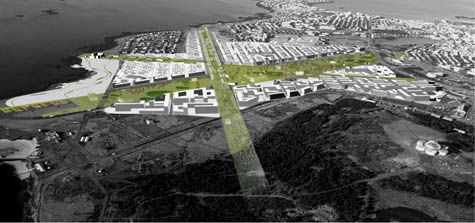
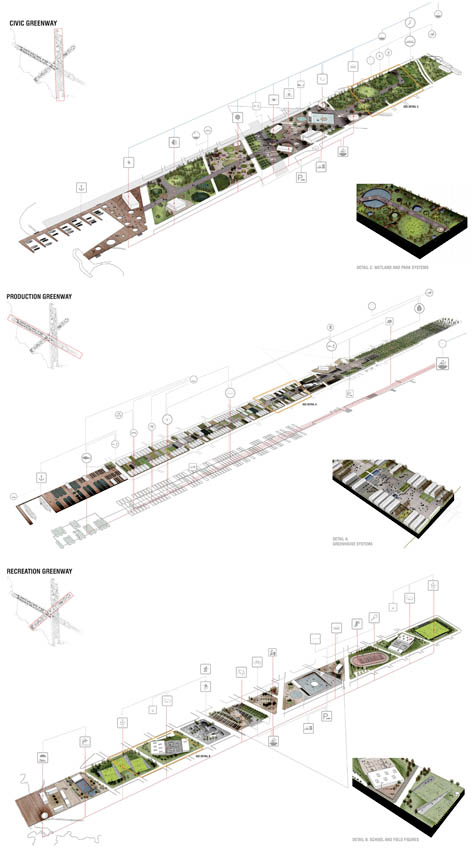 [Images: By Lola E. Sheppard and Mason White].
[Images: By Lola E. Sheppard and Mason White].
The greenways are then given new programs, or functions, which the architects define as Ecology, Recreation, and Production.
The Ecology greenway, for instance, "is conceived of as a dot-matrix of cellular ecosystems, organic rooms, landscape surfaces of hard and softscape, gardens and pools."
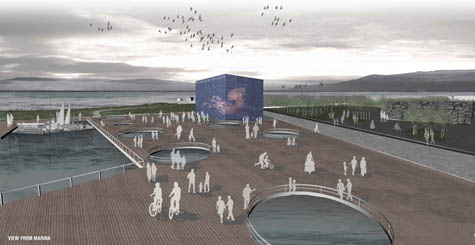
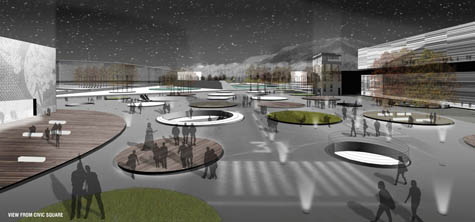 [Images: By Lola E. Sheppard and Mason White].
[Images: By Lola E. Sheppard and Mason White].
The Production greenway, which I like quite a lot, has been "treated as a barcode of interdependent production activities, with changing densities of fish farming, greenhouses for fruit, vegetable and flower production, allotment gardens, markets and tree farming."
But how spectacular to live in a city full of greenhouses! Re-formatting architectural interiors to grow fruit. You wander around at night through certain districts of your city watching strange plants grow behind glass. The air smells alive. It's quiet.
And there are fewer cars – because entire streets have been blocked off and replaced with greenhouses, freeing up former parking lots to become orchards and small croplands. Microfarms. Perhaps new coastal rivers even cut through the city, engineered by heroic valves tucked away beneath the streets, irrigating various neighborhoods and responding to lunar tides.
What used to be highway flyovers are now orange groves, and over there, in the abandoned airport, fields of medicinal flowers now grow.
 [Image: By Lola E. Sheppard and Mason White].
[Image: By Lola E. Sheppard and Mason White].
On a vaguely related note, meanwhile, my own description here has reminded me of the discovery last winter that listening to birdsong might actually improve mental health. So imagine ten thousand new birds up in the trees of this greenhouse city as the sun begins to rise over huge warehouses walled with angled glass panes, like something out of analytical Cubism, and you're just sitting there eating toast with local honey, listening to morning birdsong, surrounded by plants.
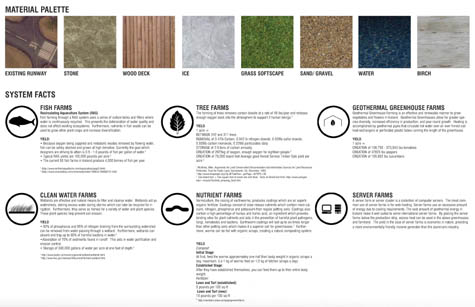 [Image: By Lola E. Sheppard and Mason White].
[Image: By Lola E. Sheppard and Mason White].
In any case, the final greenway proposed by this project would be a "recreation corridor" in which "spaces for formal and informal activities" will be built, including "soccer fields, running tracks, basketball, tennis and volleyball, local schools and playgrounds."
 [Image: By Lola E. Sheppard and Mason White].
[Image: By Lola E. Sheppard and Mason White].
The greenways will all knit together and criss-cross, following the buried logic of the old runways.
In ten years' time, you can take your kids out into the middle of a forest and say: "They used to land planes here..."
(All of these images are also available in a small Flickr set).
First, then, here's the old Vatnsmýri airport and its earthen geometry of intersecting runways. This is the site – star-like and stretching out to its surrounding landscapes – within which the designers had to work.

 [Images: The Vatnsmýri airport grounds, Reykjavík, Iceland. Photos courtesy of the Reykjavík City Planning Committee].
[Images: The Vatnsmýri airport grounds, Reykjavík, Iceland. Photos courtesy of the Reykjavík City Planning Committee].And here are some of the project entries, which I have posted in order, from shortlisted entries through to the big prize winners – but I have selected them on the purely superficial criterion of my own visual interest. Some of these projects, including two grand prize winners, are, I'm sure, absolutely fascinating, but small JPGs of their proposals simply don't give you very much to work with.
So, with genuine apologies to those designers whose work does not appear here, take a look at some of the entries.
 [Image: By Alexander D'Hooghe, et al.].
[Image: By Alexander D'Hooghe, et al.]. [Image: By Antonello Boatti, Birgir Breiðdal, and Nicola Ferrara].
[Image: By Antonello Boatti, Birgir Breiðdal, and Nicola Ferrara]. [Image: By Lola E. Sheppard and Mason White].
[Image: By Lola E. Sheppard and Mason White]. [Image: By Rolf J. Teloh, et al.].
[Image: By Rolf J. Teloh, et al.]. [Image: By Thomas Forget and Jonathan F. Bell].
[Image: By Thomas Forget and Jonathan F. Bell]. [Image: By Andrés Perea Ortega, et al.].
[Image: By Andrés Perea Ortega, et al.]. [Image: By Beatriz Ramo, et al.].
[Image: By Beatriz Ramo, et al.]. [Image: By Peer T. Jeppesen, et al.].
[Image: By Peer T. Jeppesen, et al.]. [Image: By Belinda Kerry, Andrew Lee, Fiona Harrisson, and Blake F. Bowers].
[Image: By Belinda Kerry, Andrew Lee, Fiona Harrisson, and Blake F. Bowers]. [Image: By Manuel Lodi, et al.].
[Image: By Manuel Lodi, et al.]. [Image: By Jeff Turko, Guðjón Þór Erlendsson, Dagmar Sirch, and Sibyl Trigg].
[Image: By Jeff Turko, Guðjón Þór Erlendsson, Dagmar Sirch, and Sibyl Trigg]. [Image: By Graeme Massie, Stuart Dickson, Alan Keane, and Tim Ingleby].
[Image: By Graeme Massie, Stuart Dickson, Alan Keane, and Tim Ingleby].And now I want to zero-in on one of the projects.
Here, then, is a quick exploration of a shortlisted entry by Lola E. Sheppard and Mason White of the Toronto-based firm Lateral Architecture.
 [Image: By Lola E. Sheppard and Mason White].
[Image: By Lola E. Sheppard and Mason White].Their project begins, we read, "by establishing 'no-build' zones or public landscapes. The figure of the runway is used to identify three primary axes. Each former runway is converted into a 'greenway' that uses a quality of the city as its primary trait."

 [Images: By Lola E. Sheppard and Mason White].
[Images: By Lola E. Sheppard and Mason White].The greenways are then given new programs, or functions, which the architects define as Ecology, Recreation, and Production.
The Ecology greenway, for instance, "is conceived of as a dot-matrix of cellular ecosystems, organic rooms, landscape surfaces of hard and softscape, gardens and pools."

 [Images: By Lola E. Sheppard and Mason White].
[Images: By Lola E. Sheppard and Mason White].The Production greenway, which I like quite a lot, has been "treated as a barcode of interdependent production activities, with changing densities of fish farming, greenhouses for fruit, vegetable and flower production, allotment gardens, markets and tree farming."
- Fish Farms are located on the western end of the strip and serve both a local populace through an adjacent market and an international market with a distribution port. A series of greenhouses line the edges of the existing runway and create cluster of outdoor 'rooms.' Interspersed are modest community garden and farm plots which subdivide the space and integrate the adjacent communities into the strip. A second market, proposed at the triangle intersection, serves to sell these vegetables and flowers to the Reykjavik community. A dense forest continues the barcode and creates wood for the initial construction phases. This forest gains more permanence in successive phases and is used to absorb carbon dioxide and offer oxygen to the new development.
But how spectacular to live in a city full of greenhouses! Re-formatting architectural interiors to grow fruit. You wander around at night through certain districts of your city watching strange plants grow behind glass. The air smells alive. It's quiet.
And there are fewer cars – because entire streets have been blocked off and replaced with greenhouses, freeing up former parking lots to become orchards and small croplands. Microfarms. Perhaps new coastal rivers even cut through the city, engineered by heroic valves tucked away beneath the streets, irrigating various neighborhoods and responding to lunar tides.
What used to be highway flyovers are now orange groves, and over there, in the abandoned airport, fields of medicinal flowers now grow.
 [Image: By Lola E. Sheppard and Mason White].
[Image: By Lola E. Sheppard and Mason White].On a vaguely related note, meanwhile, my own description here has reminded me of the discovery last winter that listening to birdsong might actually improve mental health. So imagine ten thousand new birds up in the trees of this greenhouse city as the sun begins to rise over huge warehouses walled with angled glass panes, like something out of analytical Cubism, and you're just sitting there eating toast with local honey, listening to morning birdsong, surrounded by plants.
 [Image: By Lola E. Sheppard and Mason White].
[Image: By Lola E. Sheppard and Mason White].In any case, the final greenway proposed by this project would be a "recreation corridor" in which "spaces for formal and informal activities" will be built, including "soccer fields, running tracks, basketball, tennis and volleyball, local schools and playgrounds."
 [Image: By Lola E. Sheppard and Mason White].
[Image: By Lola E. Sheppard and Mason White].The greenways will all knit together and criss-cross, following the buried logic of the old runways.
In ten years' time, you can take your kids out into the middle of a forest and say: "They used to land planes here..."
(All of these images are also available in a small Flickr set).





Comments are moderated.
If it's not spam, it will appear here shortly!
[In ten years' time, you can take your kids out into the middle of a forest and say: "They used to land planes here..."]
You may forget about that :)
I was planting trees for half a year in Iceland, and I've seen the slow growth on many previous plantings that were between 2 and 12 years old.
I wouldn't call it "in the middle of a forest". But maybe in 20 years. Remember: What to do, if you get lost in an icelandic forest? (just stand up!)
And more on topic:
Very interesting, indeed.
I didn't know it was this sure to abandon the Reykjavík City Airport. There were rumors for a long time about building a high speed railway from Keflavík International Airport to Reykjavík. But apparently plans are more progressed already.
I'm quite curious, whether or not action will be taken.
In the book uTOpia: Towards a New Toronto there is a project to convert Toronto's downtown airport into a residential neighborhood punctuated by large boulevards and canals (the former runways). It's an interesting concept, but I have to ask myself how much environmental remediation 80 years of jet fuel will require.
Hopefully this project, especially if it actually goes ahead, can point the way for other cities trying to figure out what to do with old airport within city limits, such as Berlin and Tempelhof.
Speaking of converting old airports, isn't there a big and controversial project in southern California to turn an old Air Force base into something like 10,000 homes? These airport projects seem to invariably be absolute political messes.
This is an excellent opportunity to settle one of life's true conundrums. Build an enormous conveyor belt then attempt take off in a 747 running against the belt.
Would it work?
I am part of a competition in detroit for an ecovillage that is quite similar to this. Not set on an airport but, due to the open land of detroit, it deals many of the same issues. As a student, this thread will be very helpful in laying out comp boards. Essentially, what info is highlighted and what is tertiary. Thank you so much for posting!
Those greenways sound positively idyllic. I love the "Production" idea, too.
As for Tempelhof, they're apparently planning on kicking off the planning process with a whole bunch of temporary installations, which could be an interesting test of that particular trendy genre...
Have these guys ever visited Iceland? Population 400,000, 300,000 of whom live in Reykjavik.... I can imagine those 'green boulevards' being really fantastic, barren, rain-driven, windswept places with about one person every 100 metres max. looks like a classic case of over-sizing public space to me. I wonder what Willie Whyte and Jan Gehl would think.
Actually the population in Iceland is only 313,000 with 118,000 living in Reykjavik. ... but the point being that not all of the public realm is meant to be occupied by all of the people all of the time.
@tim: No, it wouldn't work. To take off, the plane needs to get up to a certain speed relative to the air, not the ground. It's air moving over the wings which creates lift, after all.
What would work, though, is if you sat the plane on the belt facing in the direction of belt travel, with the plane stationary on the belt. That's basically what a steam catapult on an aircraft carrier is.
Or you could install a colossal set of fans to generate artificial wind over a stationary or slowly-moving plane, to give it extra lift. I don't know if that's ever been tried. If the wind was strong enough, the plane wouldn't need any forward speed. You would, however, need some way of holding it stationary relative to the ground after it started to take off, until it was high enough to fly away on its own. A cable would do it - basically, you turn an A380 into a titanic steel kite.
-- tom
One of my favourite Google Maps pasttimes is looking at aerial photos of southeast England and trying to find abandoned wartime airfields. There are tons of them, built as homes for the aircraft striving to defend our green and pleasant land from the ravages of the Hun. They were built to a standard pattern (two runways crossing at a 60 degree angle, with a perimiter road in the shape of a rounded cross) that is absolutely distinctive from the air. Although the airfields themselves are long gone, the boundaries that the strips and perimeters established are still present in the landscape, as roads and field boundaries, quite easily distinguished from the shakily quadrilateral Saxon fields.
A few examples:
RAF Graveley
Bradwell Bay - now farmland (the runways are used to store tractors and piles of vegetables - i've been there), but that's a nuclear power station to the north
Great Oakley - now a private aerodrome
Beccles - the runways are used for go-karting, but the site has been disrupted by a main road running through it
Is there some connection here to your theory of the military as the leading architectural visionaries of the 21st century? Maybe not, but these are still fun to look at. They're like easter eggs, hidden in the landscape.
As a bonus, here's a live one: RAF Woodbridge, Britain's answer to Roswell, being the site of the the Rendlesham Forest incident. Oooh, spooky!
-- tom
Post a Comment